El Día de los Muertos – Mexico’s Day of the Dead
El Día de los Muertos, also known as Mexico’s Day of the Dead, is a vibrant and deeply rooted tradition that holds immense cultural significance in Mexican society. This annual celebration, which takes place on November 1st and 2nd, is a time for families and communities to come together to honor and remember their deceased loved ones. While the name might suggest a somber occasion, El Día de los Muertos is anything but gloomy. It is a lively and colorful festival that celebrates the cycle of life and death in a unique and beautiful way.
History and Origins
El Día de los Muertos, or the Day of the Dead, is a vibrant and colorful celebration deeply rooted in Mexican culture and history. Its origins can be traced back to ancient Mesoamerican civilizations, particularly the Aztec festival dedicated to the goddess Mictecacihuatl, the Lady of the Dead. This pre-Columbian tradition honored deceased ancestors and celebrated the cycle of life and death. With the arrival of Spanish conquistadors in the 16th century, these indigenous customs merged with Catholic traditions, giving rise to the modern-day observance of El Día de los Muertos as we know it.
The essence of El Día de los Muertos lies in the belief that on this day, the spirits of the departed return to the world of the living to reunite with their loved ones. Families create elaborate altars, known as ofrendas, adorned with photos, candles, incense, and the favorite foods and drinks of the deceased. Marigolds, known as cempasúchil, are scattered to guide the spirits home, while sugar skulls and pan de muerto (bread of the dead) are offered as sweet treats for both the living and the dead.
One of the most iconic symbols of the Day of the Dead is the calavera, or skull, which is often depicted in various art forms during the festivities. Calaveras can be whimsical or macabre, serving as a reminder of the inevitability of death and the importance of cherishing life. Another significant element is papel picado, intricately cut paper banners that decorate homes and altars, symbolizing the fragile nature of existence.
Throughout history, El Día de los Muertos has evolved into a rich tapestry of customs and practices that vary from region to region in Mexico. In some areas, families hold all-night vigils at cemeteries, sharing stories and memories of the departed. In others, parades and processions fill the streets with music, dance, and elaborate costumes. These regional variations highlight the diversity and depth of Mexican cultural heritage.
As the world becomes increasingly interconnected, the traditions of El Día de los Muertos have transcended borders and gained international recognition. From Hollywood films to museum exhibitions, the vibrant imagery and symbolism of the celebration have captured the imagination of people around the globe. Despite this global appeal, the essence of the Day of the Dead remains deeply rooted in family ties, community spirit, and the enduring connection between the living and the dead.
Traditions and Customs
When it comes to El Día de los Muertos, traditions and customs play a central role in honoring and celebrating the lives of departed loved ones. This vibrant and colorful Mexican holiday is rich in symbolism and practices that have been passed down through generations, creating a deep cultural tapestry that is both unique and captivating.
One of the most iconic traditions of El Día de los Muertos is the creation of altars, known as ofrendas, adorned with photographs, candles, incense, and the favorite foods and drinks of the deceased. These altars serve as a focal point for families to gather and pay their respects, creating a sacred space filled with memories and love.
Another beloved custom is the making of sugar skulls, or calaveras de azúcar, intricately decorated with bright colors and patterns. These sweet treats are often personalized with the names of the departed and serve as both a festive decoration and a symbolic offering to honor the spirits of the dead.
Marigolds, known as cempasúchil, hold special significance during El Día de los Muertos, as their vibrant orange petals are believed to guide the souls of the departed back to the living world. These flowers are used to decorate altars, gravesites, and streets, creating a path of light and beauty for the returning spirits.
Visits to cemeteries are also a key aspect of the Day of the Dead celebrations, where families gather to clean and decorate the graves of their loved ones. It is a time of reflection, prayer, and storytelling, as memories are shared and the presence of the deceased is felt in a tangible way.
Overall, the traditions and customs of El Día de los Muertos are deeply rooted in honoring the cycle of life and death, celebrating the continuity of family ties, and embracing the beauty of remembrance. It is a time of joy, reflection, and connection that brings communities together in a spirit of love and unity.
Symbolism and Meaning
When delving into the rich tapestry of El Día de los Muertos, one cannot ignore the profound symbolism and deep meanings woven into this vibrant celebration. At its core, this tradition is a poignant reflection on the cycle of life and death, where death is not feared but embraced as an integral part of the human experience. The ubiquitous presence of calaveras, or skulls, serves as a powerful symbol of mortality and the transient nature of life, reminding us of our shared destiny.
Another significant element of El Día de los Muertos is papel picado, intricately cut paper banners that adorn altars and streets during the festivities. These delicate decorations symbolize the fragile boundary between the living and the dead, as well as the ephemeral nature of existence. The intricate patterns and designs carved into the papel picado mirror the intricate interconnectedness of life and death, highlighting the beauty found in both realms.
Furthermore, the portrayal of death in Mexican culture during this celebration is not one of sorrow or mourning, but rather a joyful commemoration of those who have passed. The vibrant colors, lively music, and fragrant marigolds all come together to create a festive atmosphere that honors the departed souls. Through these symbolic gestures, El Día de los Muertos becomes a colorful tapestry of remembrance, love, and respect for the deceased.
In Mexican folklore, it is believed that during this time of year, the spirits of the departed return to visit their loved ones. The offerings of favorite foods, drinks, and mementos placed on altars are not just material objects but symbolic gestures of hospitality and welcome. By creating a welcoming space for the spirits, families reaffirm their connection to their ancestors and ensure that their memories endure through generations.
Regional Variations
When it comes to El Día de los Muertos, Mexico’s Day of the Dead, regional variations play a significant role in shaping the diversity and richness of this cultural celebration. Each region in Mexico has its own unique traditions and customs that reflect the local heritage and beliefs of the community.
In Southern Mexico, particularly in the state of Oaxaca, El Día de los Muertos is celebrated with elaborate street parades and vibrant displays of colorful papel picado. Families create intricate altars adorned with marigolds, candles, and photos of deceased loved ones, honoring their memory with heartfelt offerings of food and drinks.
On the other hand, in the central region of Mexico, such as in Mexico City, the Day of the Dead festivities may include mass gatherings in cemeteries where families come together to clean and decorate the graves of their ancestors. It is a time of reflection and connection with the past, as people share stories and memories of those who have passed away.
In the Yucatán Peninsula, a fusion of Mayan and Spanish influences can be seen in the celebration of El Día de los Muertos. Here, families prepare traditional dishes like poc chuc and cochinita pibil to offer to the spirits of the departed. The use of copal incense and the incorporation of Mayan rituals add a unique flavor to the festivities.
Furthermore, in the northern regions of Mexico, such as Chihuahua and Nuevo León, the Day of the Dead is marked by a more subdued and intimate observance. Families gather for quiet dinners at home, sharing stories and memories of their ancestors in a more private setting.
Overall, the regional variations in Mexico’s El Día de los Muertos showcase the country’s cultural diversity and the deep-rooted connections between communities and their ancestors. Each region brings its own flavor and customs to the celebration, adding layers of richness and meaning to this cherished tradition.
Modern Interpretations
Modern Interpretations of El Día de los Muertos have transcended traditional boundaries, finding new expressions in various art forms and media. Artists, filmmakers, writers, and creators worldwide have been captivated by the vibrant imagery and profound symbolism of this Mexican celebration, incorporating it into their works with a contemporary twist.
One of the most notable modern interpretations is the use of El Día de los Muertos motifs in mainstream fashion and pop culture. From runway shows to merchandise, the iconic calaveras and colorful papel picado have become synonymous with a trendy and edgy aesthetic, appealing to a global audience seeking to embrace the rich cultural heritage of Mexico.
Furthermore, the fusion of technology and tradition has given rise to innovative ways of commemorating the Day of the Dead. Virtual altars, interactive exhibits, and digital art installations now offer immersive experiences that blend ancient rituals with modern digital storytelling, allowing people to engage with the festival in unprecedented ways.
In the realm of cinema and literature, El Día de los Muertos has inspired a myriad of narratives that explore themes of memory, loss, and the afterlife. Films like “Coco” have brought the beauty and depth of Mexican traditions to a worldwide audience, sparking conversations about family, legacy, and the enduring power of remembrance.
Moreover, contemporary artists continue to push the boundaries of creativity by reimagining traditional Day of the Dead iconography in bold and provocative ways. Through mixed media, street art, and installations, they challenge perceptions and invite viewers to contemplate the intersection of life and death, the ephemeral and the eternal.
Overall, the modern interpretations of El Día de los Muertos serve as a testament to the enduring relevance and universal appeal of this ancient tradition. By blending the old with the new, the sacred with the secular, artists and creators celebrate the spirit of remembrance and renewal that lies at the heart of this beloved Mexican festival.
Family and Community Gatherings
Family and community gatherings play a central role in the vibrant tapestry of El Día de los Muertos, fostering a sense of unity, remembrance, and connection among loved ones. During this sacred time, families come together to honor their ancestors, creating elaborate altars adorned with marigolds, candles, photos, and favorite foods of the departed. These altars, known as ofrendas, serve as a focal point for reflection and celebration, symbolizing the enduring bond between the living and the dead.
One of the most cherished traditions of El Día de los Muertos is the sharing of meals with family and friends. Communities gather to enjoy traditional dishes such as tamales, mole, pan de muerto, and atole, savoring the flavors of their heritage while recounting stories of those who have passed on. Through the act of sharing food and memories, individuals strengthen their familial ties and pass down cultural traditions from one generation to the next.
Community events and parades also play a significant role in the festivities, bringing people together in a joyous display of music, dance, and colorful costumes. These lively gatherings create a sense of camaraderie and shared identity, uniting individuals in a collective expression of love and respect for the departed. Whether through music, dance, or art, the spirit of El Día de los Muertos thrives in the communal spaces where families and neighbors come together to honor their heritage and celebrate life.
Connection to Halloween
When exploring the in the context of El Día de los Muertos, it becomes evident that these two celebrations share certain similarities while also embodying distinct cultural identities. While Halloween is widely known for its spooky costumes, trick-or-treating, and jack-o’-lanterns, El Día de los Muertos focuses on honoring deceased loved ones with vibrant altars, marigolds, and sugar skulls.
Both holidays fall around the same time of year, with Halloween on October 31st and El Día de los Muertos spanning from October 31st to November 2nd. However, their origins and underlying themes diverge significantly. Halloween traces back to Celtic Samhain traditions, marked by the belief in spirits roaming the earth, while El Día de los Muertos has deep roots in indigenous Aztec rituals honoring the goddess Mictecacihuatl, the Lady of the Dead.
Despite these differences, the can be seen in the shared focus on death and the afterlife. Both holidays embrace the concept of mortality in unique ways, with Halloween leaning towards fear and spookiness, and El Día de los Muertos embracing death as a natural part of the cycle of life to be celebrated and remembered.
Impact of Tourism
When it comes to El Día de los Muertos, the impact of tourism cannot be overlooked. As this traditional Mexican holiday gains global recognition, the influx of tourists has both positive and negative effects on its observance. On one hand, tourism offers an opportunity for cultural exchange, allowing people from around the world to learn about and participate in this rich tradition. It can also bring economic benefits to local communities, supporting artisans, vendors, and businesses that cater to visitors during the festivities.
However, the commercialization of El Día de los Muertos due to tourism can sometimes dilute its authenticity and significance. As the holiday becomes more popular among tourists, there is a risk of it being misrepresented or commodified for commercial gain. Traditional practices may be altered or exaggerated to cater to tourist expectations, potentially undermining the true essence of the celebration.
Furthermore, the sheer volume of tourists during El Día de los Muertos can put a strain on local resources and infrastructure. Cemeteries and sacred sites may become overcrowded, impacting the ability of locals to pay their respects to their deceased loved ones in a peaceful and meaningful manner. The increased traffic and footfall can also lead to environmental concerns, such as littering and damage to cultural heritage sites.
Future of the Tradition
As we look towards the future of El Día de los Muertos, we are faced with the intersection of tradition and modernity, where the past meets the present in a delicate dance of preservation and adaptation. The evolution of this centuries-old celebration is inevitable, influenced by changing societal dynamics, technological advancements, and global interconnectedness.
One of the key questions that arise when contemplating the future of this tradition is how it will continue to evolve in a rapidly changing world. Will the essence of El Día de los Muertos remain intact, rooted in its rich cultural heritage, or will it undergo further transformations to resonate with contemporary sensibilities?
Globalization plays a significant role in shaping the future trajectory of El Día de los Muertos, as the festival gains international recognition and popularity. The spread of information and ideas across borders brings both opportunities and challenges, influencing how the tradition is perceived and practiced beyond its Mexican origins.
Moreover, the younger generations, growing up in a digital age characterized by constant innovation and evolving norms, may reinterpret El Día de los Muertos in ways that reflect their own experiences and values. The fusion of traditional customs with modern expressions could breathe new life into the celebration, ensuring its relevance for years to come.
As we navigate the complexities of preserving tradition while embracing change, it is essential to strike a balance that honors the essence of El Día de los Muertos while embracing the possibilities of the future. The resilience of this cultural heritage lies in its ability to adapt and evolve, remaining a vibrant and cherished part of Mexican identity.
Frequently Asked Questions
- What is El Día de los Muertos?
El Día de los Muertos, or the Day of the Dead, is a traditional Mexican holiday that honors and remembers deceased loved ones. It is a vibrant celebration of life and death, filled with colorful rituals and symbolic elements.
- When is El Día de los Muertos celebrated?
El Día de los Muertos takes place annually on November 1st and 2nd, coinciding with the Catholic holidays of All Saints’ Day and All Souls’ Day. The festivities typically begin on October 31st.
- What are some common traditions associated with El Día de los Muertos?
Some of the key traditions include building altars (ofrendas) adorned with photos, candles, marigolds, and favorite foods of the deceased, creating sugar skulls (calaveras de azúcar), and visiting gravesites to pay respects.
- How is El Día de los Muertos different from Halloween?
While Halloween focuses on costumes and trick-or-treating, El Día de los Muertos is a more solemn occasion centered around honoring deceased ancestors and celebrating their lives. Both holidays have roots in honoring the dead but differ in cultural practices and symbolism.
- Is El Día de los Muertos only celebrated in Mexico?
While El Día de los Muertos has its origins in Mexico, it is also observed in other Latin American countries and by Mexican communities around the world. Each region may have its unique customs and interpretations of the holiday.
Dia de los Muertos, Mexico, sugar skulls, marigolds, altars, spirits, celebration, family, , Dia de los Muertos, Mexico, sugar skulls, marigolds, altars, spirits, celebration, family,
Share this content:
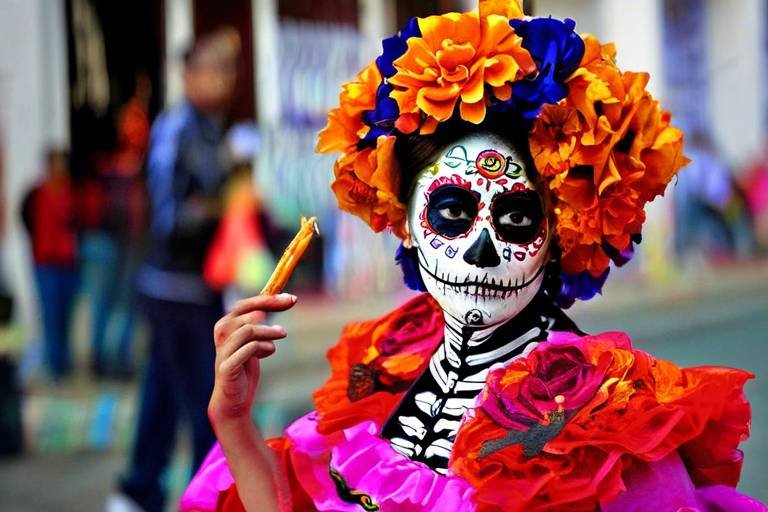
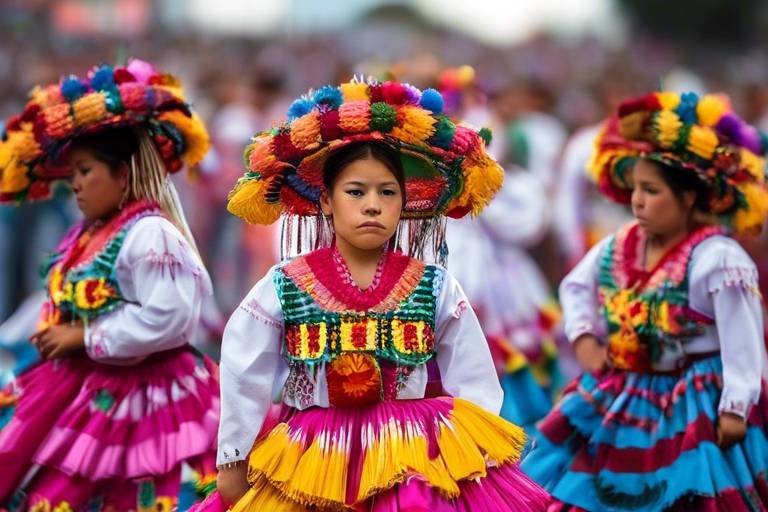





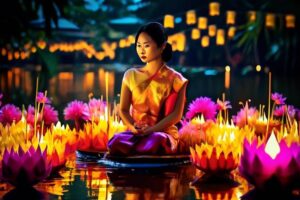

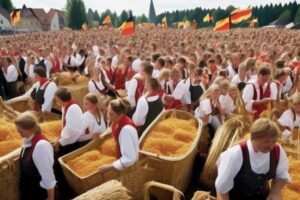
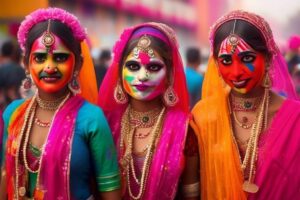

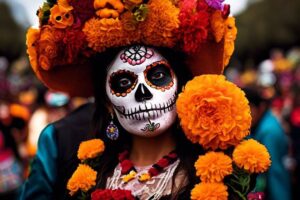

Post Comment